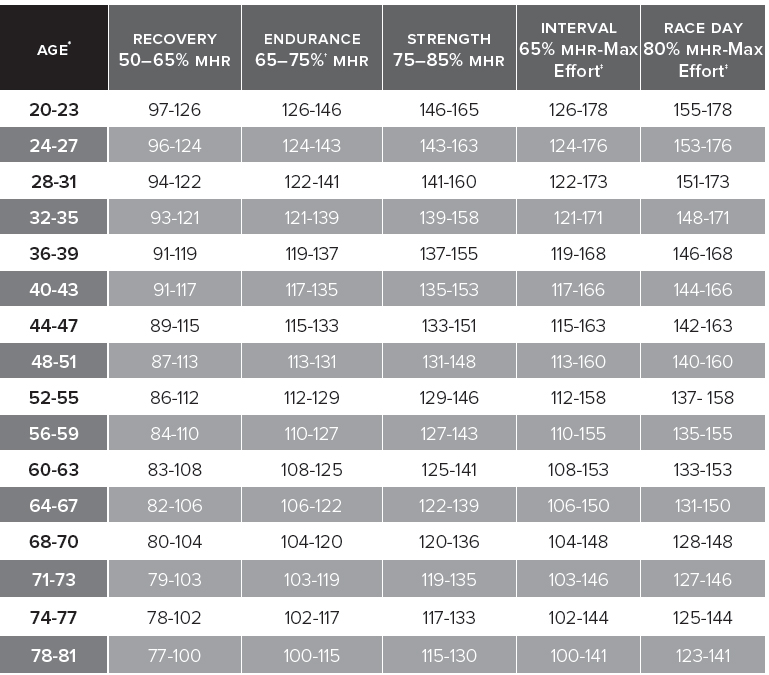Spinning Energy Zones® Heart Rate Chart

Wearing a heart rate monitor while exercising provides instant, continuous heart rate display that keeps you in check with your training goals.
Endurance Energy Zones®
The lowdown: Endurance training is your foundation and should constitute the bulk of your workouts.
The payoff: Shorter recovery times, higher fat metabolism and a lower resting heart rate.
Resistance: Light
to moderate
Cadence: 80–110 RPM
Intensity: 65%–75% of maximum heart rate
Frequency: 3–4 times per week
Strength Energy Zones®
The lowdown: Using high resistance and a slower cadence, you'll hover between aerobic and anaerobic zones.
The payoff: Tone your legs and build your mental strength.
Resistance: Moderate to heavy
Cadence: 60–80 RPM
Intensity: 75%–85% of maximum heart rate
Frequency: 1–2 times per week
once you’ve built a strong aerobic base
Interval Energy Zones®
The lowdown: Alternate bursts of speed and power with recovery.
The payoff: You'll increase
your aerobic and anaerobic capacity, which will lead to bolstered stamina and endurance.
Resistance: Light to heavy
Cadence: 60–110 RPM
Intensity: 65%–92% of maximum heart rate
Frequency: 1 time per week once you’ve built a strong aerobic base
Race Day Energy Zones®
The lowdown: Challenge your body and celebrate your strength.
The payoff: Training at
or above anaerobic threshold teaches your body to perform at higher intensities.
Resistance: Moderate to heavy
Cadence: 60–110 RPM
Intensity: 80%–92% maximum heart rate
Frequency: Monthly
Recovery Energy Zones®
The lowdown: Without sufficient rest, your body can't get stronger.
The payoff: Recovery
Rides promote healing and circulate oxygen to tired muscles, ligaments and tendons.
Resistance: Light
Cadence: 80–110 RPM
Intensity: 50–65% of maximum heart rate
Frequency: 1–2 times per week
A heart rate chart tells you the average number of heart beats per minute you experience as your heart pumps blood through your system. When the amount of energy you exert increases, your heart rate increases in turn. Before testing your rate during your exertion, you should test your resting heart rate, the number of beats in one minute while you are in a state of rest. This will tell you your basic overall heart health and fitness level. As you become more conditioned, less effort will be needed to pump blood through your body, and your resting heart rate will actually decrease.
You can read the heart rate chart by age, finding your age bracket and reading across several Spinning® Energy Zones®. Spinning® Energy Zones® and the cycling heart rate zones in each column change dependent on age, so make sure to check your correct bracket to ensure you're pacing yourself accurately, ensuring your safety during your workout.
If possible, you should also check your maximum heart rate, the highest number of beats your heart contracts during a one minute measurement. A safe heart rate is typically about 60% of the maximum heart rate, so knowing your max HR can be very beneficial in measuring the necessary intensity of your training and ensuring you stay within a safe range. While the most accurate method to determine your individual maximum heart rate is to be clinically tested on a treadmill, women can get an approximate measurement by subtracting their age from 226, and men by subtracting their age from 220.
Each Spinning Energy Zone® is broken down based on different elements of your workout, from interval training all the way to your ideal heart rate on a potential race day. One of the chief benefits of a Spinning® class is the ability to adapt your workout to your own needs without having to worry about exterior elements, and utilizing the different Energy Zones® can go a long way towards ensuring you are maximizing your performance and receiving the greatest benefit in regards to the work you're putting in. The differences between Energy Zones® may seem minor, but over the course of a sustained fitness regimen, even small changes can add up, leading to substantial increases in strength and endurance and overall health. For more information about each column of the chart, including greater detail on Spinning® Energy Zones® and desired revolution cadences for each zone, check out the breakdowns on each workout section, listed below.